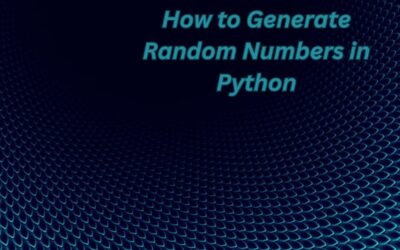Random numbers are essential in programming, serving various purposes from simulating real-world scenarios to implementing algorithms dependent on randomness. In Python, there exist several methods for generating random numbers, each tailored to specific needs and implementations. This tutorial delves into the basics of Random Numbers in Python, covering pseudorandom number generators and the Python standard library, while also exploring advanced techniques with NumPy.
Pseudorandom Number Generators
Pseudorandom Number Generators (PRNGs) are algorithms designed to produce sequences of numbers that exhibit characteristics of randomness. Unlike truly random processes, such as radioactive decay or atmospheric noise, PRNGs are deterministic, meaning that their output is entirely determined by an initial seed value. The sequences they generate may appear random for practical purposes, but they eventually repeat after a certain period, known as the cycle length.
import random
# Set the seed for reproducibility
random.seed(42)
# Generate pseudorandom numbers
random_numbers = [random.random() for _ in range(5)]
print("Pseudorandom numbers:", random_numbers)Applications and Security Considerations
PRNGs find widespread use in computer science, cryptography, and simulations where a consistent sequence of seemingly random numbers is needed. However, the deterministic nature of PRNGs introduces vulnerabilities, especially in cryptographic applications, where predictability could be exploited. To enhance security, cryptographic systems often require cryptographically secure pseudorandom number generators (CSPRNGs) that pass specific tests for unpredictability and resist statistical attacks, providing a higher level of randomness assurance.
Random Numbers Generators
Generating random numbers is a common programming task, and Python simplifies this process with its random module. This module, part of the standard library, offers functions like random.random() for floats, random.randint(a, b) for integers, and random.choice(seq) for sequence elements. It strikes a balance between randomness and repeatability, facilitating tasks such as simulations, games, and statistical sampling.
import random
# Generate a random float between 0 and 1
random_float = random.random()
# Generate a random integer between a and b
random_int = random.randint(a, b)
# Choose a random element from a sequence
random_element = random.choice(seq)Seeding the RNG
Seeding the random number generator (RNG) is a crucial step in the realm of computer science and programming, particularly when dealing with algorithms that involve randomness. The term “seed” refers to the initial input provided to the RNG, serving as the starting point for generating a sequence of seemingly unpredictable numbers.
Generating Random Floating-Point Values
Generating random floating-point values in Python can be achieved using the random.random() function, which generates a float between 0 and 1. Additionally, the random.uniform(a, b) function can be used to generate a float within a specified range [a, b].
import random
# Generate a random floating-point number between 0 and 1
random_float = random.random()
print("Random float between 0 and 1:", random_float)
# Generate a random floating-point number between a specified range
random_float_range = random.uniform(10.0, 20.0)
print("Random float between 10.0 and 20.0:", random_float_range)Control and Precision with Libraries
Programmers often use libraries or built-in functions that provide methods for generating random floats, allowing them to control the range and precision of the generated values. It’s crucial to note that these random values are usually not truly random but are generated through deterministic processes, making them suitable for a wide range of applications without requiring true randomness.
Applications of Random Floating-Point Values in Python
- Simulations: Random floating-point values are used to introduce variability in simulations, such as Monte Carlo simulations, weather modeling, or financial risk analysis.
- Games: Game developers utilize random floating-point values to create unpredictable game elements, such as random enemy positions, item drops, or terrain generation.
- Statistical Modeling: Random floating-point values are employed in statistical modeling tasks, including generating random samples for hypothesis testing, bootstrapping, or simulating data distributions.
- Experimental Design: Researchers use random floating-point values to randomize experimental conditions or assign treatments randomly in controlled experiments to reduce bias.
- Optimization Algorithms: Randomness is often incorporated into optimization algorithms, such as genetic algorithms or simulated annealing, to explore a wide range of solutions and avoid local optima.
Random Gaussian Values:
Generating random values from a Gaussian (normal) distribution is a common task in various statistical and machine learning applications. In Python, you can achieve this using the random module’s gauss(mu, sigma) function or the numpy.random.normal(loc, scale, size) function from the NumPy library.
Here’s a brief overview of each method:
- Using the
randommodule:
import random
# Generate a random value from a Gaussian distribution with mean mu and standard deviation sigma
mu = 0 # Mean
sigma = 1 # Standard deviation
random_gaussian = random.gauss(mu, sigma)- Using NumPy:
import numpy as np
# Generate an array of random values from a Gaussian distribution with mean loc and standard deviation scale
loc = 0 # Mean
scale = 1 # Standard deviation
size = 10 # Number of values to generate
random_gaussian_array = np.random.normal(loc, scale, size)Both methods allow you to specify the mean (loc) and standard deviation (scale) of the Gaussian distribution. The random.gauss() function generates a single random value, while np.random.normal() generates an array of random values. Adjusting the mean and standard deviation allows you to control the center and spread of the generated values, respectively.
Adding Unpredictability to Decision-Making
Randomly choosing from a list is a versatile technique, injecting unpredictability into decision-making processes. In programming, it introduces variability in simulations, creates randomized game elements, and enhances user experience by shuffling content dynamically.
Applications in Everyday Decision-Making
Random selection from a list is not limited to programming; it finds utility in everyday scenarios like choosing a restaurant, deciding on a movie, or picking a travel destination. The introduced randomness adds an element of excitement and surprise to routine decision-making.
For Subsampling
Subsampling, particularly in the context of data analysis or machine learning, often involves randomly selecting a subset of data points from a larger dataset. In Python, you can use various techniques and libraries to generate random numbers for subsampling.
One common approach is to use the random.sample() function from the built-in random module to randomly select a specified number of unique elements from a sequence without replacement.
Here’s an example of how you can use random.sample() for subsampling:
import random
# Original dataset (list of data points)
original_data = [1, 2, 3, 4, 5, 6, 7, 8, 9, 10]
# Number of data points to subsample
subsample_size = 5
# Subsampled data
subsampled_data = random.sample(original_data, subsample_size)
print("Subsampled data:", subsampled_data)
This code snippet will randomly select 5 unique elements from the original_data list without replacement and store them in subsampled_data.
If you’re working with larger datasets or arrays, you might also consider using the numpy.random.choice() function from the NumPy library, which offers more flexibility and efficiency for subsampling operations. Here’s how you can use it:
import numpy as np
# Original dataset (NumPy array)
original_data = np.array([1, 2, 3, 4, 5, 6, 7, 8, 9, 10])
# Number of data points to subsample
subsample_size = 5
# Subsampled data
subsampled_data = np.random.choice(original_data, size=subsample_size, replace=False)
print("Subsampled data:", subsampled_data)In this example, np.random.choice() selects 5 random elements from the original_data array without replacement and returns them as a new NumPy array.
For Unbiased Samples
The built-in random module in Python provides functions for generating random numbers that are suitable for unbiased sampling. The random.uniform(a, b) function, for instance, generates a random floating-point number in the range [a, b), where all values within the range have an equal probability of being selected.
Here’s how you can use random.uniform() to generate unbiased samples:
import random
# Define the range for sampling
min_value = 0
max_value = 100
# Generate a random number within the specified range
random_number = random.uniform(min_value, max_value)
print("Random number:", random_number)In this example, random.uniform(min_value, max_value) generates a random floating-point number between min_value (inclusive) and max_value (exclusive). All numbers within this range have an equal probability of being chosen, ensuring unbiased sampling.
For generating unbiased samples from a list or array, you can use functions like random.shuffle() or numpy.random.shuffle() to shuffle the elements randomly before selecting a subset. This ensures that each element has an equal chance of being selected, resulting in an unbiased sample.
Here’s an example using random.shuffle():
import random
# Original dataset
original_data = [1, 2, 3, 4, 5, 6, 7, 8, 9, 10]
# Shuffle the elements randomly
random.shuffle(original_data)
# Select a subset of elements for sampling
sample_size = 5
sampled_data = original_data[:sample_size]
print("Sampled data:", sampled_data)By shuffling the elements randomly before sampling, you ensure that the sample is unbiased and representative of the original dataset. This approach is particularly useful when dealing with lists or arrays where the order of elements may affect the sampling process.
Understanding List Shuffling
Understanding list shuffling is useful in various scenarios, such as:
- Generating random permutations for Monte Carlo simulations or random sampling.
- Creating randomized sequences for games or randomized algorithms.
- Ensuring fairness in random selection processes, such as conducting randomized experiments or assigning random treatments in controlled trials.
Python’s Built-in Function for List Shuffling
The shuffling algorithm works by iteratively swapping elements within the list to create a new arrangement where each element has an equal chance of appearing at any position. Python, for instance, provides a built-in function called random. shuffle() that efficiently shuffles the elements of a list. Randomly shuffling a list is not only a practical programming skill but also serves as a versatile tool for various applications where introducing randomness is essential for achieving fairness or enhancing the diversity of data.
import random
# Original list
original_list = [1, 2, 3, 4, 5]
# Shuffle the elements of the list randomly
random.shuffle(original_list)
print("Shuffled list:", original_list)Random Numbers with NumPy:
a. Seed The Random Numbers in Python:
Seeding the NumPy random number generator is crucial for reproducibility, ensuring that the same sequence of random numbers is generated every time the code is run. This is particularly useful for debugging or sharing code where deterministic results are desired.
Here’s how you can seed the NumPy random number generator:
import numpy as np
# Set the seed for reproducibility
np.random.seed(42)
# Generate random numbers
random_numbers = np.random.rand(5)
print("Random numbers:", random_numbers)In this example, np.random.seed(42) sets the seed to 42, ensuring that the subsequent calls to random number generation functions will produce the same sequence of random numbers.
b. Array of Random Floating Point Values:
NumPy offers the np.random.rand() function to generate arrays of random floating-point values in the interval [0, 1). You can specify the shape of the array as arguments to the function.
import numpy as np
# Generate a 1D array of random floating-point values
random_floats_1d = np.random.rand(5)
print("1D array of random floats:", random_floats_1d)
# Generate a 2D array of random floating-point values
random_floats_2d = np.random.rand(3, 2)
print("2D array of random floats:", random_floats_2d)c. Array of Random Integer Values:
To create arrays of random integers using NumPy, you can use the np.random.randint() function. It allows you to specify the range of integers and the shape of the resulting array.
import numpy as np
# Generate a 1D array of random integers between 0 and 9
random_integers_1d = np.random.randint(0, 10, size=5)
print("1D array of random integers:", random_integers_1d)
# Generate a 2D array of random integers between 0 and 99
random_integers_2d = np.random.randint(0, 100, size=(3, 2))
print("2D array of random integers:", random_integers_2d)d. Array of Random Gaussian Values:
NumPy provides the np.random.normal() function to generate arrays of random values from a normal (Gaussian) distribution. You can specify the mean and standard deviation of the distribution, along with the shape of the resulting array.
import numpy as np
# Generate a 1D array of random Gaussian values with mean 0 and standard deviation 1
random_gaussian_1d = np.random.normal(0, 1, size=5)
print("1D array of random Gaussian values:", random_gaussian_1d)
# Generate a 2D array of random Gaussian values with mean 10 and standard deviation 2
random_gaussian_2d = np.random.normal(10, 2, size=(3, 2))
print("2D array of random Gaussian values:", random_gaussian_2d)e. Shuffle NumPy Array:
You can shuffle the elements of a NumPy array using the np.random.shuffle() function. This function shuffles the array in place, modifying the original array.
import numpy as np
# Create a NumPy array
my_array = np.array([1, 2, 3, 4, 5])
# Shuffle the array
np.random.shuffle(my_array)
print("Shuffled array:", my_array)f. Modern Ways of Random Number Generation in NumPy:
Recent versions of NumPy introduced modern methods of random number generation, including the Generator and BitGenerator classes. These classes provide more control and flexibility over random number generation processes.
import numpy as np
# Create a Generator object
rng = np.random.default_rng()
# Generate random numbers using the Generator object
random_numbers = rng.random(5)
print("Random numbers using Generator:", random_numbers)These modern methods offer advantages such as improved performance, thread safety, and the ability to work with multiple independent streams of random numbers.
Further Reading:
To learn more about generating random numbers in Python, you can explore additional resources like tutorials and documentation available online.
Summary:
Understanding random numbers in Python is important for many tasks, like analyzing data or building machine learning models. This guide covers the basics of generating random numbers, using Python’s built-in tools and NumPy for more advanced techniques. With this knowledge, you’ll be able to use random numbers effectively in your Python projects.






